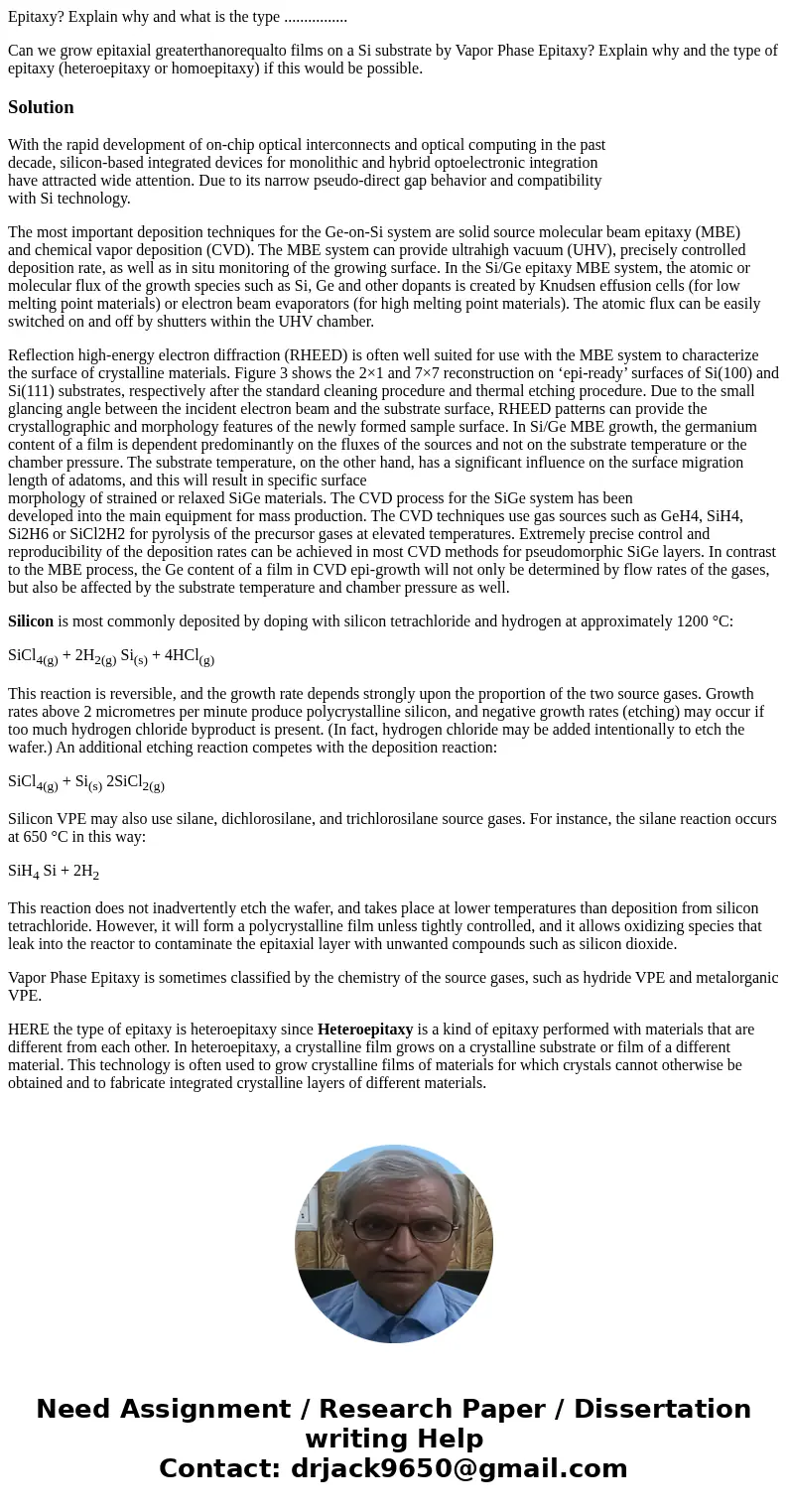Epitaxy Explain why and what is the type Can we grow epitax
Epitaxy? Explain why and what is the type ................
Can we grow epitaxial greaterthanorequalto films on a Si substrate by Vapor Phase Epitaxy? Explain why and the type of epitaxy (heteroepitaxy or homoepitaxy) if this would be possible.Solution
With the rapid development of on-chip optical interconnects and optical computing in the past
decade, silicon-based integrated devices for monolithic and hybrid optoelectronic integration
have attracted wide attention. Due to its narrow pseudo-direct gap behavior and compatibility
with Si technology.
The most important deposition techniques for the Ge-on-Si system are solid source molecular beam epitaxy (MBE)
and chemical vapor deposition (CVD). The MBE system can provide ultrahigh vacuum (UHV), precisely controlled
deposition rate, as well as in situ monitoring of the growing surface. In the Si/Ge epitaxy MBE system, the atomic or molecular flux of the growth species such as Si, Ge and other dopants is created by Knudsen effusion cells (for low melting point materials) or electron beam evaporators (for high melting point materials). The atomic flux can be easily switched on and off by shutters within the UHV chamber.
Reflection high-energy electron diffraction (RHEED) is often well suited for use with the MBE system to characterize the surface of crystalline materials. Figure 3 shows the 2×1 and 7×7 reconstruction on ‘epi-ready’ surfaces of Si(100) and Si(111) substrates, respectively after the standard cleaning procedure and thermal etching procedure. Due to the small glancing angle between the incident electron beam and the substrate surface, RHEED patterns can provide the crystallographic and morphology features of the newly formed sample surface. In Si/Ge MBE growth, the germanium content of a film is dependent predominantly on the fluxes of the sources and not on the substrate temperature or the chamber pressure. The substrate temperature, on the other hand, has a significant influence on the surface migration length of adatoms, and this will result in specific surface
morphology of strained or relaxed SiGe materials. The CVD process for the SiGe system has been
developed into the main equipment for mass production. The CVD techniques use gas sources such as GeH4, SiH4, Si2H6 or SiCl2H2 for pyrolysis of the precursor gases at elevated temperatures. Extremely precise control and reproducibility of the deposition rates can be achieved in most CVD methods for pseudomorphic SiGe layers. In contrast to the MBE process, the Ge content of a film in CVD epi-growth will not only be determined by flow rates of the gases, but also be affected by the substrate temperature and chamber pressure as well.
Silicon is most commonly deposited by doping with silicon tetrachloride and hydrogen at approximately 1200 °C:
SiCl4(g) + 2H2(g) Si(s) + 4HCl(g)
This reaction is reversible, and the growth rate depends strongly upon the proportion of the two source gases. Growth rates above 2 micrometres per minute produce polycrystalline silicon, and negative growth rates (etching) may occur if too much hydrogen chloride byproduct is present. (In fact, hydrogen chloride may be added intentionally to etch the wafer.) An additional etching reaction competes with the deposition reaction:
SiCl4(g) + Si(s) 2SiCl2(g)
Silicon VPE may also use silane, dichlorosilane, and trichlorosilane source gases. For instance, the silane reaction occurs at 650 °C in this way:
SiH4 Si + 2H2
This reaction does not inadvertently etch the wafer, and takes place at lower temperatures than deposition from silicon tetrachloride. However, it will form a polycrystalline film unless tightly controlled, and it allows oxidizing species that leak into the reactor to contaminate the epitaxial layer with unwanted compounds such as silicon dioxide.
Vapor Phase Epitaxy is sometimes classified by the chemistry of the source gases, such as hydride VPE and metalorganic VPE.
HERE the type of epitaxy is heteroepitaxy since Heteroepitaxy is a kind of epitaxy performed with materials that are different from each other. In heteroepitaxy, a crystalline film grows on a crystalline substrate or film of a different material. This technology is often used to grow crystalline films of materials for which crystals cannot otherwise be obtained and to fabricate integrated crystalline layers of different materials.

 Homework Sourse
Homework Sourse